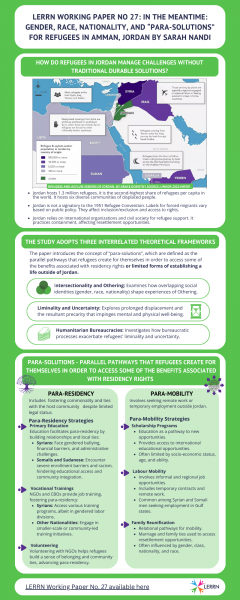Working Paper 27
Sarah Nandi, Department of Political Science, McGill University
Oroub El Abed, International Migration and Refugee Studies, Birzeit University
Megan Bradley, Department of Political Science, McGill University
Hamzah Qardan, USAID, Jordan
Executive Summary
 The three durable solutions, namely resettlement to a third country, local integration, and voluntary repatriation, aim to resolve refugeehood. However, these traditional pathways are no longer feasible for the majority of refugees. How different refugees access or think about solutions for their situation, including their perceptions and pursuit of the traditional and alternative pathways, are shaped by intersecting factors such as gender, race, nationality, and class. In order to better understand how different displaced communities navigate this “meantime” period of liminality, this study draws upon interviews with refugees and humanitarian staff in Amman, Jordan to examine the paths that refugees make for themselves even under enormous risk and constraints. To do so, we propose the concept of “para-solutions”, which can be understood as the parallel pathways that refugees create for themselves to access some of the benefits associated with residency rights or limited forms of establishing a life outside of Jordan. Para-solutions include both the tangible practices that refugees use in solutions-making in the present as well as the future hope attached to the different strategies. We examine para-solutions through two sub-categories: para-residency and para-mobility. Para-residency includes solutions that are localized in the Jordanian setting, deal mainly in the temporal present, and include practices such as pursuing education, vocational training, and volunteering opportunities.
The three durable solutions, namely resettlement to a third country, local integration, and voluntary repatriation, aim to resolve refugeehood. However, these traditional pathways are no longer feasible for the majority of refugees. How different refugees access or think about solutions for their situation, including their perceptions and pursuit of the traditional and alternative pathways, are shaped by intersecting factors such as gender, race, nationality, and class. In order to better understand how different displaced communities navigate this “meantime” period of liminality, this study draws upon interviews with refugees and humanitarian staff in Amman, Jordan to examine the paths that refugees make for themselves even under enormous risk and constraints. To do so, we propose the concept of “para-solutions”, which can be understood as the parallel pathways that refugees create for themselves to access some of the benefits associated with residency rights or limited forms of establishing a life outside of Jordan. Para-solutions include both the tangible practices that refugees use in solutions-making in the present as well as the future hope attached to the different strategies. We examine para-solutions through two sub-categories: para-residency and para-mobility. Para-residency includes solutions that are localized in the Jordanian setting, deal mainly in the temporal present, and include practices such as pursuing education, vocational training, and volunteering opportunities.
Para-mobility is often focused on the future by including a hopefulness for what may become possible outside of Jordan and operates through higher education scholarships, short-term labour contracts in other countries or online, or travel through family relationships and marriage. Together, these para-solutions offer a more complete and intersectional representation of what “solutions” look like from the perspectives of refugees and show how the traditional pathways are always situated within a much broader solutions spectrum that challenges preconceived notions of belonging while also speaking to the critical role of hope.
View the full LERRN Working Paper Series here:
DOI
Citation
Nandi, S., El Abed, O., Bradley, M., Qardan, H. (2024). In The Meantime: Gender, Race, Nationality, and “Para- Solutions” for Refugees in Amman, Jordan. Accessibility Institute at Carleton University, Ottawa. https://doi.org/10.22215/glrnw/244001